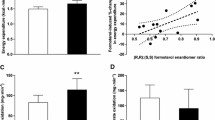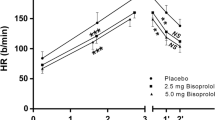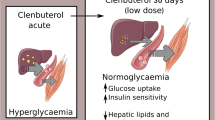Summary
Inhibition of adipose tissue lipolysis may be involved in the impairment of endurance capacity after administration of a β-adrenoceptor blocker. During endurance exercise, no significant decrease in plasma glycerol and free fatty acid (NEFA) concentrations after β-adrenoceptor blockade is found. However, the levels during recovery from exhaustion are lower after β-adrenoceptor blockade. This study was designed to investigate whether the lower levels after exercise are due to β-adrenoceptor blockade or to the shorter time to exhaustion after administration of a β-adrenoceptor blocker.
In a single-blind study, 11 well-trained male subjects (age 23 (0.9) y) performed a cycle ergometer test at 70% Wmax until exhaustion 2 h after intake of 80 mg propranolol. One week later, the test was repeated after intake of placebo and was stopped at the time of exhaustion in the previous test. Average exercise time was 24 min. During exercise plasma glucose was lower, whereas plasma lactate and the respiratory exchange ratio were significantly higher when the subjects were on propranolol. Glycerol and NEFA concentrations during exercise were not significantly different between the two conditions. Despite an identical exercise time, glycerol and NEFA concentrations during recovery were significantly lower after propranol treatment.
In conclusion, lipolysis is inhibited during exercise after propranolol, probably causing a shift from fat to carbohydrate combustion.
Similar content being viewed by others
References
Arner P, Kriegholm E, Engfeldt P, Bolinder J (1990) Adrenergic regulation of lipolysis in situ at rest and during exercise. J Clin Invest 85: 893–898
Bloom SR, Johnson RH, Park DM, Rennie MJ, Sulaiman WR (1976) Differences in the metabolic and hormonal response to exercise between racing cyclists and untrained individuals. J Physiol (London) 258: 1–18
Borg G (1970) Perceived exertion as an indicator of somatic stress. Scand J Rehab Med 2: 92–98
Chick TW, Halperin AK, Gacek EM (1988) The effects of antihypertensive medications on exercise performance, a review. Med Sci Sports Exerc 20: 447–454
Cleroux J, Nguyen van P, Taylor AW, Leenen FH (1989) Effects of β1 vs. β1 + β2-blockade on exercise endurance and muscle metabolism in humans. J Appl Physiol 66: 548–554
Dill DB, Costill DL (1974) Calculations of percentages changes in the volume of blood, red cells and plasma in dehydration. J Appl Physiol 37: 247–248
Havel RJ, Naimark A, Borchgrevink CF (1963) Turnover rate and oxidation of free fatty acids of blood plasma in man during exercise, studies during continuous infusion of palmitate-1-C14. J Clin Invest 42: 1054–1063
Hodgetts V, Coppack SW, Frayn KN, Hockaday TD (1991) Factors controlling fat mobilization from human subcutaneous adipose tissue during exercise. J Appl Physiol 71: 445–451
Holloszy JO, Rennie MJ, Hickson RC, Conlee RK, Hagberg JM (1977) Physiological consequences of the biochemical adaptations to endurance exercise. Ann NY Acad Sci 301: 440–450
Jesek JK, Martin NB, Broeder CE, Thomas EL (1990) Changes in plasma free fatty acids and glycerols during prolonged exercise in trained and hypertensive persons taking propranolol and pindolol. Am J Cardiol 66: 1336–1341
Juhlin-Dannfelt A (1983) Beta-adrenoceptor blockade and exercise, effects on endurance and physical training. Acta Med Scand [Suppl] 672: 49–54
Kather H, Bieger W, Michel G, Aktories K, Jakobs KH (1985) Human fat cell lipolysis is primarily regulated by inhibitory modulators acting through distinct mechanisms. J Clin Invest 76: 1559–1565
Lethonen A, Huupponen R, Himanen P (1984) Effect of the short-term beta-adrenoceptor blockade on exercise metabolism in cold weather. Int J Clin Pharmacol Ther Toxicol 22: 86–90
Lundborg P, Aström H, Bengtsson C, Fellenius E (1981) Effect of beta-adrenoceptor blockade on exercise performance and metabolism. Clin Sci 61: 299–305
MacDonald A, Bennett T, Brown AM, Wilcox RG, Skene AM (1984) The effects of acute or chronic ingestion of propranolol or metoprolol on the metabolic and hormonal response to prolonged submaximal exercise in hypertensive men. Br J Clin Pharmacol 17: 283–293
Martin III WH, Coyle EF, Joyner M, Santensanio D, Ehsani AA, Holloszy JO (1984) Effects of stopping exercise training on epinephrine-induced lipolysis in humans. J Appl Physiol 56: 845–848
McLeod AA, Brown JE, Kitchell BB, Sedor FA, Kuhn C, Shand DG, Williams RS (1984) Hemodynamic and metabolic responses to exercise after adrenoceptor blockade in humans. J Appl Physiol 56: 7165–722
Siscovick DS, Laporte RE, Newman JH (1985) The disease-specific benefits and risks of physical activity and exercise. Public Health Reports 100: 180–185
Sjogaard G, Adams RP, Saltin B (1985) Water and ion shifts in skeletal muscle of humans with intense dynamic knee extension. Am J Physiol 248: R190-R196
Van Baak MA, Böhm ROB, Petri J, Rahn KH (1987) Metabolic effects of verapamil and propranolol during submaximal endurance exercise in patients with essential hypertension. Int J Sports Med 8: 270–274
Van Baak MA (1988) Beta-adrenoceptor blockade and exercise: an update. Sports Med 5: 209–225
Wolfe RR, Klein S, Carraro F, Weher JM (1990) Role of triglyceridefatty acid cycle in controlling fat metabolism in humans during and after exercise. Am J Physiol 258: E382-E389
Zerbe GD (1979) Randomization analysis of randomized blocks design extended to growth and response curves. Commun Stat Theor Meth 8A: 191–205
Author information
Authors and Affiliations
Rights and permissions
About this article
Cite this article
Wijnen, J.A.G., van Baak, M.A., de Haan, C. et al. Beta-blockade and lipolysis during endurance exercise. Eur J Clin Pharmacol 45, 101–105 (1993). https://doi.org/10.1007/BF00315488
Received:
Accepted:
Issue Date:
DOI: https://doi.org/10.1007/BF00315488




